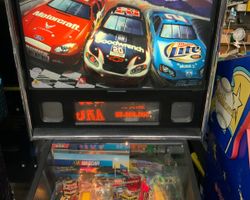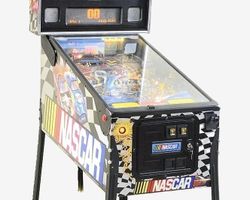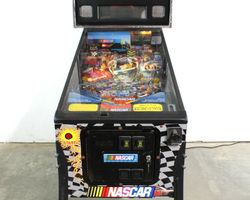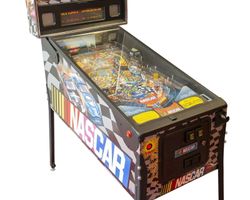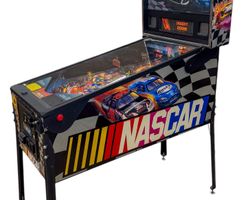NASCAR®
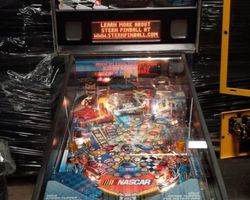
Average Prices: USD $1,700 to $3,200
Produced: August, 2005
Machine Type: Solid State Electronic
MPU: Stern Whitestar (modified)
Players: 4
Concept by: Pat Lawlor
Design by: Pat Lawlor, Louis Koziarz
Art by: John Youssi
Dots/Animation by: Adam Rhine, Greg Dunlap
Mechanics by: John Krutsch, John Filz
Music by: Chris Granner
Sound by: Chris Granner
Software by: Louis Koziarz, Chip Curtis
"NASCAR" by Stern Pinball, released in June 2005, represents a significant collaboration within the pinball industry, bringing the high-octane world of stock car racing to the silverball experience. Manufactured by Stern Pinball, Inc., the machine draws its theme directly from the popular American motorsport, featuring elements, teams, and drivers familiar to racing fans. The inspiration stemmed from a desire to capture the speed, competition, and excitement of NASCAR, translating it into a dynamic pinball layout.
The design and production of "NASCAR" involved a confluence of established talent. Pat Lawlor, known for his ability to craft engaging playfields with exceptional flow, contributed to the design and concept. Louis Koziarz shared design responsibilities and handled the software, ensuring the game’s mechanics and rules were cohesive. The visual identity of the machine was shaped by John Youssi, whose artwork brought the racing theme to life on the playfield and cabinet. Chris Granner composed the music and sounds, integral to setting the thematic atmosphere, including the distinct engine noises and crowd reactions. The mechanical aspects were overseen by John Krutsch, while Adam Rhine and Greg Dunlap contributed to the animation package displayed on the dot-matrix screen. This collaborative effort aimed to deliver an immersive and authentic racing experience.
"NASCAR" was released with an initial production run of approximately 3,500 units, making it a moderately produced title for its time. A notable aspect of its production history is its parallel release as "Grand Prix" for the international market, featuring an identical layout and gameplay but with a generic racing theme. Later, in 2007, Stern produced a limited edition run of 600 units titled "Dale Jr.," which utilized the same core design but incorporated specific cosmetic changes, including chrome trim, custom backglass art, cabinet decals, and playfield color variations, all celebrating the driver Dale Earnhardt Jr. The machine also features custom speech from Allen Bestwick, a well-known NASCAR television analyst, providing authentic race commentary, and includes Sammy Hagar's popular song "I Can't Drive 55" as a musical track, further enhancing the racing theme. The game showcases cars from three specific race teams and their drivers: the No. 2 Miller Lite Dodge driven by Rusty Wallace of Penske Racing South, the No. 29 GM Goodwrench Chevrolet driven by Kevin Harvick of Richard Childress Racing, and the No. 21 Motorcraft Ford driven by Ricky Rudd of Wood Brothers Racing, rooting the game in real-world racing identities.
Signature Features and Design
"NASCAR" distinguishes itself with several unique features that directly integrate the racing theme into gameplay. The most prominent of these is the innovative "racetrack loop" that encircles a significant portion of the playfield perimeter. This mechanism allows the pinball to travel at high speed around the outer track, simulating a lap on a racecourse. The successful execution of this shot is both visually engaging and audibly satisfying, directly contributing to the game's sense of speed and competition.
Another thematic element is the "Test Car X" model car, a physical toy located prominently in the center of the playfield. This rotating car not only serves as a visual centerpiece but also acts as a target, often triggering modes or accumulating points when struck. Its movement adds a dynamic element to the playfield, creating varied shot opportunities. Additionally, the presence of three powerful magnets on the playfield strategically influences ball movement, adding an element of unpredictability and challenging players to react quickly, mimicking the tight maneuvers and unpredictable nature of racing. A miniature hauler truck toy is also present, further enhancing the racing garage aesthetic. The machine also incorporates a 3-bank drop target setup, requiring precise shots to advance objectives. These signature elements combine to create an immersive environment that consistently reminds players they are in a high-speed race.
Playfield and Mechanics
The playfield layout of "NASCAR" is designed for speed and flow, characteristic of Pat Lawlor's design philosophy. The primary goal was to create a fast-paced game that encourages continuous ball movement and satisfying shot combinations. The playfield features two main ramps, one on each side, which are critical for navigating the ball around the layout and accessing various modes and scoring opportunities. Three pop bumpers are positioned strategically to create exciting, randomized deflections, often sending the ball back into the main playfield area or towards shot entries. Two slingshots further contribute to the lively ball movement.
Major shots include the two ramps, the racetrack loop, and a central target area around the "Test Car X." A captive ball and a Newton ball offer additional targets that require precision to hit for points or to advance features. The 3-bank drop targets provide a classic pinball challenge, resetting when all targets are felled, often revealing a shot or initiating a mode. The overall flow is open, allowing for quick transitions between shots, and rewarding players who can maintain ball control and string together combinations.
The artwork by John Youssi integrates racing imagery throughout the playfield, depicting detailed race cars, pit crew members, and track elements, all rendered in vibrant colors that enhance the sense of speed and energy. The lighting design complements the artwork, using bright LEDs to highlight active shots and progression, drawing the player's eye to current objectives. The overall aesthetic is one of a bustling racetrack, with elements designed to evoke the excitement of a live NASCAR event, from the grandstands in the backglass to the detailed car models on the playfield.
Gameplay Dynamics
"NASCAR" features gameplay mechanics centered around qualifying, racing, and achieving various objectives to secure a victory. The progression typically involves completing a series of shots to qualify for specific races, then engaging in those races through further shot completion. The scoring system rewards consistent hits on the main ramps and the unique racetrack loop. Successful laps on the loop increment a lap counter, building towards bonuses and special awards.
The machine includes several distinct modes and challenges. Activating "race modes" involves hitting specific targets or ramps, each representing a different stage or challenge within a race scenario. The game offers five different multiball modes, each with its own unique introduction and scoring opportunities, providing intense, high-scoring segments. For instance, successfully hitting the drop targets or specific ramp shots can initiate these multiball sequences, where the objective shifts to hitting as many targets as possible with multiple balls in play.
Player strategies often revolve around mastering the high-speed loop shot and skillfully managing the ball to activate and sustain multiball. The callouts from Allen Bestwick provide real-time race commentary, reacting to player actions and enhancing the immersive experience. The integration of Sammy Hagar’s “I Can’t Drive 55” as a multiball theme song adds a burst of energy, creating a memorable gameplay highlight during these chaotic moments. The game's straightforward ruleset ensures accessibility for casual players while offering enough challenge and depth to engage more experienced enthusiasts seeking to maximize scores and complete all racing objectives.
Reception and Legacy
"NASCAR" has garnered a mixed but generally positive reception within the pinball community since its release. Many players found the game surprisingly enjoyable and entertaining, even those who were not particular fans of the NASCAR theme itself. It is often described as an underrated machine, perhaps overshadowed by other licensed titles of the era or misconceptions regarding its theme. Enthusiasts frequently praise its distinct features and fast-paced gameplay, highlighting its capacity for quick, exciting sessions.
Strengths often cited include the unique racetrack loop, a feature consistently lauded as innovative and well-integrated into the theme. The flow of the playfield is frequently commended, allowing for smooth, satisfying shot combinations. Many appreciate the straightforward yet challenging ruleset, making it an accessible game for newcomers while still providing depth for seasoned players. The thematic execution, including the specific cars, drivers, and the authentic voiceover, resonated well with those who enjoyed the sport. Reviewers also frequently mention the high-energy multiball introductions and sequences as a highlight. For many, "NASCAR" offers substantial value for its market price, especially when considering its gameplay and unique mechanics.
However, "NASCAR" also faced criticism. Some feedback pointed to the artwork and overall presentation, particularly the translite, as less captivating or feeling somewhat dated compared to other titles. The perceived "cheapness" of some physical toys, like the "Test Car X," was also a point of contention for a segment of players. While some appreciated the sound package, others found the music, particularly "I Can't Drive 55," and certain callouts to be repetitive or lacking in variety. Concerns about gameplay depth for long-term ownership were sometimes raised, with some players desiring a more intricate ruleset. Mechanical issues like airballs or perceived build quality in certain areas were also noted by a few.
Despite its criticisms, "NASCAR" has cultivated a reputation as a solid, high-energy pinball machine that delivers on its theme. Its legacy is tied to its unique approach to integrating a racing theme, particularly through the prominent racetrack loop, which remains a standout design element. While it may not have fundamentally altered pinball machine design or established a new sub-genre, its impact lies in demonstrating how a licensed sports theme can be effectively translated into a fast and engaging pinball experience, appealing to both casual players and collectors seeking an accessible yet exciting game.
Sponsored Links
 Ebay Listings
Ebay Listings
 Auction Results
Auction Results
| Cost | Location | Date |
|---|---|---|
| USD $3,300 |  California, United States California, United States |
29 September, 2025 |
| USD $3,500 |  Indiana, United States Indiana, United States |
16 July, 2025 |
| USD $2,799 |  Pennsylvania, United States Pennsylvania, United States |
25 June, 2025 |
| USD $2,850 |  Pennsylvania, United States Pennsylvania, United States |
18 May, 2025 |
| USD $1,100 |  Florida, United States Florida, United States |
12 May, 2025 |
| USD $3,100 |  Arizona, United States Arizona, United States |
15 April, 2025 |
| USD $6,200 |  Florida, United States Florida, United States |
10 February, 2025 |
| USD $6,990 |  Tennessee, United States Tennessee, United States |
22 November, 2024 |
| USD $5,499 |  California, United States California, United States |
13 September, 2024 |
| USD $2,200 |  Maryland, United States Maryland, United States |
07 December, 2023 |


Private Policy · Search Website · Contact Us
As an eBay Partner, we may earn a commission from qualifying purchases made through links on this site, at no additional cost to you.
All trademarks and copyrighted materials remain property of their respective owners. All other content copyright 2007 - 2025 Pinpedia.

